Internet & Network Tweaks
Internet Explorer 9 & 10
Increase Max Connections
Why: This tweak may be able to increase your page loads and possibly your download speed.
Why not: Too many connections could possibly get you banned or disconnected from web sites (and others may limit your number).
This tweak may be able to increase your page loads and possibly your download speed.
*2 notes
1 – Folks were in such a hurry to post this tweak when ie8 came out that the vast majority of places are using the wrong registry keys, making their so-called tweak useless. (most were trying to use the old 1/2 open connections tweak)
2 – Every post I’ve seen seems to mention that 10 is the max for this setting. Other than the fact that that is the number that Microsoft suggests you use I do not know where this came from as I’ve seen no Microsoft documentation to suggest this is the max. So, I tested the vales 10, 16, 24, and 50 under both XP and Vista. Under Vista I was able to establish 10 and 16 connections but not 24 or 50. Under XP I was able to establish 10, and 16. Under the setting of 24 and 50 I was able to max out at 20. Now there can be a variety of reasons for this which is too in depth for this article. Today in real world browsing and downloading, I don’t know that you’ll see a difference after 10 connections which is what the below tool sets it at. I’m going to set mine at 16. Keep in mind that too many connections could possibly get you banned or disconnected from web sites (and others may limit your number).
If you want to do a quick test yourself try this link and hit refresh several times to hit your max:
http://www.spasche.net/files/parallel_connections
See here for the default settings and more info: Connectivity Enhancements in Internet Explorer 8
The easy way:

Go here and click on the Fix It icon: How do I configure Internet Explorer to download more than two files at one time?
Clicking on that icon will download the file EnableTenIEDownloadSessions.msi. Double-click it to run it.
This changes adds the following to the registry (I know because I monitored it):
[HKEY_CURRENT_USER\Software\Microsoft\Windows\CurrentVersion\Internet Settings]
“MaxConnectionsPerServer”=dword:0000000a
“MaxConnectionsPer1_0Server”=dword:0000000a
The hard way:
Below are the registry keys. You’ll notice it is different than the one above (decimal value of 16 vs. 10 above)
[HKEY_CURRENT_USER\Software\Microsoft\Windows\CurrentVersion\Internet Settings]
“MaxConnectionsPer1_0Server”=dword:00000010
“MaxConnectionsPerServer”=dword:00000010
I’ve put these all in a text file for you below. It is called ie8maxconnections.txt. To make it a registry file simply rename it to a file with a .reg extension.
i.e. – ie8maxconnections.reg .
Right-click on this link an click “save link as” or “save target as”. ie8maxconnections.txt
Firefox
Recommended Add-ons:
Adblock Plus – Ad / pop-up blocker
IE View – adds right-click and other options to view a web page in Internet Explorer.
NoScript – This is a security add-on but some folks don’t like the hassle.
Tweak Network – Careful with this sometimes it helps, sometimes it doesn’t. For most folks Firefox runs just fine as-is.
There are many good Add-ons for Firefox. Some speed things up, some add functionality, others add neat little features like weather info. I would only urge you to limit what add-ons you use to stuff you really want or need. Loading too many add-ons can hinder performance.
Disable Automatic Image Resizing:
Why: User Preference.
Why not: Images larger than your screen can make web page views erratic.
Open Firefox > in the address bar type about:config > scroll down to the line: browser.enable_automatic_image_resizing , double-click it to change its value to false.
Remove the Search pane:
Why: User preference.
Why not: You’ll have to manually go to your search page.
Open Firefox > go to View > Toolbars > Customize. Click (and hold) in the search box and drag it into the Customize Toolbar box.
Google Chrome
Recommended Extensions:
Adblock Plus – Ad/pop-up blocker
Network Settings
For me, my benchmarks have shown that Windows 7 out-of-the-box is equally as fast as XP and Linux that have been tweaked. To date I’ve not found a single tweak for Windows 7 that speeds up actual networking or downloading from the net. Any tweaks here should be done separately from other tweaks.
So why tweak it? The tweaks here are designed to cut down on network chatter and to secure your box (see here for an example of the chatter I’m talking about).
Let me make this clear though. I’ve seen no network performance improvement using these tweaks and I do not believe any home users will. These settings do not cover Services, for those see the Services section of this guide.
Possible settings to disable:
Client for Microsoft Networks
This IS the Workstation Service. This service is complex and third party applications may depend on this being there.
Disabling this is often recommended for SERVER hardening.
Essential if networked.
If you are going to disable this I highly recommend:
Doing this tweak completely separate from all other actions, and,
disabling this, File and Printer Sharing for Microsoft Networks, rebooting and checking all your applications and error logs.
Very advanced users may also want to block the associated ports via the firewall.
QOS
Unneeded for the home user, (and in truth is unused in most home environments).
File and Printer Sharing for Microsoft Networks
Needed if you connect to another computer or vice versa. (see Client for Microsoft Networks above)
Internet Protocol Version 6 (TCP/IPv6)
For many users this is an essential component. HomeGroup, VPN, DirectAccess and other parts of the operating system use this.
You should keep ipv6 enabled even if your ISP doesn’t provide ipv6 connectivity yet.
“The Argument against Disabling IPv6
It is unfortunate that some organizations disable IPv6 on their computers running Windows Vista or Windows Server 2008, where it is installed and enabled by default. Many disable IPv6-based on the assumption that they are not running any applications or services that use it. Others might disable it because of a misperception that having both IPv4 and IPv6 enabled effectively doubles their DNS and Web traffic. This is not true.
From Microsoft’s perspective, IPv6 is a mandatory part of the Windows operating system and it is enabled and included in standard Windows service and application testing during the operating system development process. Because Windows was designed specifically with IPv6 present, Microsoft does not perform any testing to determine the effects of disabling IPv6. If IPv6 is disabled on Windows Vista, Windows Server 2008, or later versions, some components will not function. Moreover, applications that you might not think are using IPv6—such as Remote Assistance, HomeGroup, DirectAccess, and Windows Mail—could be.
Therefore, Microsoft recommends that you leave IPv6 enabled, even if you do not have an IPv6-enabled network, either native or tunneled. By leaving IPv6 enabled, you do not disable IPv6-only applications and services (for example, HomeGroup in Windows 7 and DirectAccess in Windows 7 and Windows Server 2008 R2 are IPv6-only) and your hosts can take advantage of IPv6-enhanced connectivity.”
Support for IPv6 in Windows Server 2008 R2 and Windows 7
Internet Protocol Version 4 (TCP/IPv4)
Essential
Link-Layer Topology Discovery Mapper I/O Driver & Link-Layer Topology Discovery Responder
Basically this enables the pretty little Network Map in Vista and Windows 7.
From what I’ve observed these protocols are basically inactive until you or someone on your network tries to view the network map.
There are 2 problems with the Network Map.
The first is that it only works from Vista and Windows 7 so it is useless on XP machines (put they can be seen if you install the LLTD Responder for XP).
The second problem is that it ain’t perfect: see Troubleshoot problems with computers not appearing on the network map.
*I’m told there is an update that allows Xboxes to be seen with LLTD.
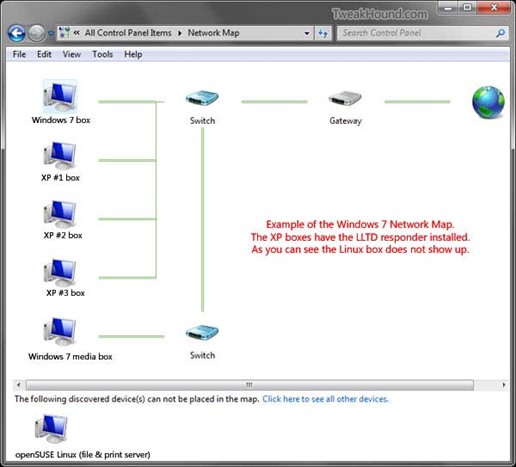
I’ve divided the tweaks into 3 separate categories.
Pick the category that applies to you and make your window look the same as the one in that category.
Note – unchecking these items does not uninstall them, it unbinds them from that specific connection.
Access Network Connection Properties
To get there:
Right-click on the Network icon in your system tray and choose Open Network and Sharing Center > click on Change adapter settings > choose the Local Area Connection and/or Wireless Network Connection, right-click and choose Properties.
To get there faster press the Windows + R keys and type ncpa.cpl > choose the Local Area Connection and/or Wireless Network Connection, right-click and choose Properties.
*Tip – Yes, you can configure each connection differently!
*Tip – While your here, if you aren’t going to use one of the connections, disable it (right-click > Disable). On my laptop I disable the Wireless connection while at home because I network it via Ethernet. When needed I just come back here and enable it.
Default
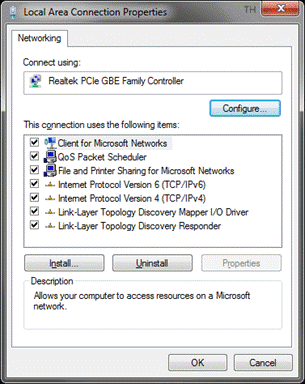
Networked, Sharing (no network map)
If you want the Network Map then leave the Link-Layer entries checked.
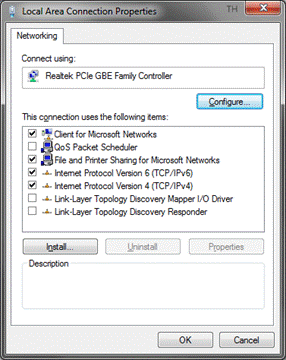
Not Networked, For Advanced Users Only
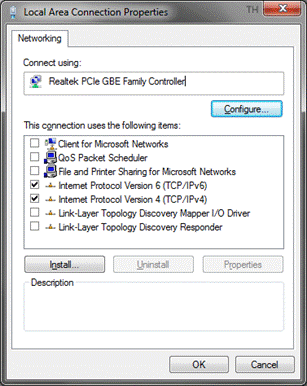
Windows 7 Firewall
This is just a basic overview. Advanced discussion of the Windows 7 Firewall would be an article in itself.
“A firewall is software or hardware that checks information coming from the Internet or a network, and then either blocks it or allows it to pass through to your computer, depending on your firewall settings.” Firewall: frequently asked questions
You should always be behind a hardware firewall. At home this is usually your ISP supplied router.
Open Windows Firewall settings > press the Windows + R keys > type firewall.cpl ( Control Panel, view large icons > Windows Firewall).
You shouldn’t muck with too many things here unless you understand what you are doing.
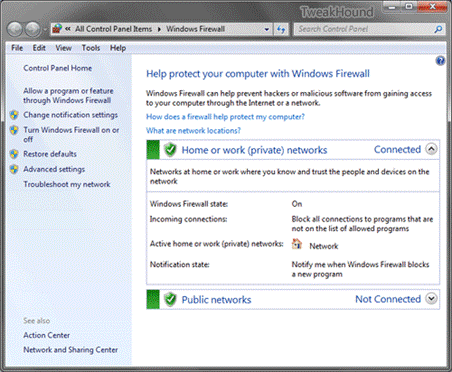
Check to see how your firewall is doing on the internet:
Go to Shields Up > read up on what the test does then click the Proceed button > click on All Service Ports.
Example of Shields Up results.
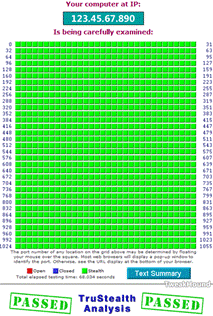
Links you should check out:
What’s New in Windows Firewall with Advanced Security (aimed at Advanced Users / IT)
Microsoft Online Safety (aimed at Home Users)
Microsoft Security (aimed at Advanced Users / IT)
Other Network Tweaks
Uninstall Remote Differential Compression
Why: This is unneeded in a home network. In Vista problems were associated with this feature.
Why not: Can’t think of a reason not to!
Go to Start Orb > Control Panel > Programs > Uninstall a program > Turn Windows Features on or off.
Deselect (uncheck), Remote Differential Compression. Click OK and then reboot if prompted.
MSDN – Remote Differential Compression
Disable Vista Auto-Tuning
Please read Notes below first!
*These are run from the command prompt. Start > Run (or press the Windows+R keys)> type cmd, hit Enter > copy/paste command, hit Enter.
Disable:
netsh int tcp set global autotuninglevel=disable
Enable:
netsh int tcp set global autotuninglevel=normal
You can also use Microsoft Fix It for this issue (ignore different OS warning, settings are the same for Windows 7).
Notes – There are any number of variables that can have an effect on your network speed. Some (usually older) network equipment can’t do Window Tuning. Some download methods / programs (torrent etc.) may also have issues with Windows Tuning. I DO NOT use this tweak.
More info:
New Networking Features in Windows Server 2008 and Windows Vista,
Description of the Receive Window Auto-Tuning feature for HTTP traffic on Windows Vista-based computers
Home Networking
This is just a where to find info section. Fully covering this topic would require writing a book.
New to Windows 7 is the HomeGroup. It is a fast convenient way for folks to network their home computers.
You don’t need to look to other websites for guides or tutorials to set up home networking in Windows 7. Microsoft has all the info you need.
HomeGroup Overview – Whitepaper from Microsoft that has everything most folks could want to know about the HomeGroup and how to use it.
Windows 7 & HomeGroup: Sharing with Windows XP, Windows Vista, and other operating systems
File sharing essentials
What is the difference between a domain, a workgroup, and a homegroup?
